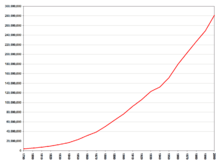US population reaches 300 million
Saturday, October 21, 2006

On Tuesday, October 17, 2006 at 7:46 A.M. (EDT), the estimated population of the United States crossed the 300 million mark.
The United States population reached the 100 million mark in 1915 and the 200 million mark 52 years later in 1967. Only 39 years later, it has touched 300 million.
In 1967, when the population reached 200 million, President Lyndon Johnson held a news conference at the Commerce Department to "hail America's past and to talk about the challenges ahead".
While the current administration doesn't appear to have similar public celebrations for the 300 million mark as President Johnson had for the 200 million mark, Commerce Secretary Carlos Gutierrez said to the Associated Press "I would hate to think that we are going to be low key about this...I would hope that we make a big deal about it."
During the year the population reached 200 million, David E. Lilienthal, the former chairman of the Atomic Energy Commission, grimly predicted that 300 million people would cause the country to be impoverished and polluted with scarce national resources. "A population of at least 300 million by 2000 will, I now believe, threaten the very quality of life of individual Americans."

Sam Roberts of The New York Times notes that while the United States' population is growing by slightly less than 1 percent per year, the nation is the third largest in population behind China and India, each with populations over 1 billion. The United States continues to be gaining people while many other industrialized nations are not; Japan's population is actually decreasing.
In terms of regional distribution, there has also been major change. Between 1970 and 2000, the portion of population in the southern and western United States went from 48 percent to 58 percent. The Population Reference Bureau also notes a rise in suburbia in the 30 year gap. While the percentage of the population living in cities remained around 30 percent, the percentage of people living in the suburbs rose from 38 percent to 50 percent.

John McCormick discussed in Chicago Tribune how the make-up of the US population has certainly changed from 1967 to today. Then, Italy was the country where most foreign born people came from more than any other; in 2006 that nation is Mexico. And in the 39 year span, the percentage of foreign-born U.S. citizens has more than doubled from 5 percent to 12 percent today. According to the Population Reference Bureau, almost 50 percent of Americans under 5 years of age are members of a minority, be it racial or ethnic.
The U.S. Bureau of the Census maintains a current estimated U.S. population count on its website.
Sources
edit- Associated Press. "U.S. population hits 300 million mark" — MSNBC, October 17, 2006
- John McCormick. "Next Stop for U.S. Population" — Chicago Tribune, October 5, 2006
- Sandra Yin. "The United States at 300 Million" — Population Reference Bureau, September, 2006
- Sam Roberts. "Come October, Baby Will Make 300 Million or So" — The New York Times, January 13, 2006
- United States Census Bureau. "Statistical Abstract of the United States" — United States Census Bureau, 2005
External links
edit- Population Clock at the U.S. Bureau of the Census website.